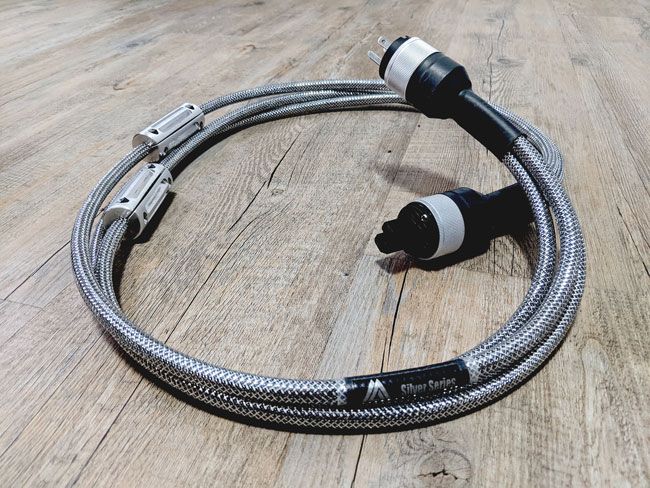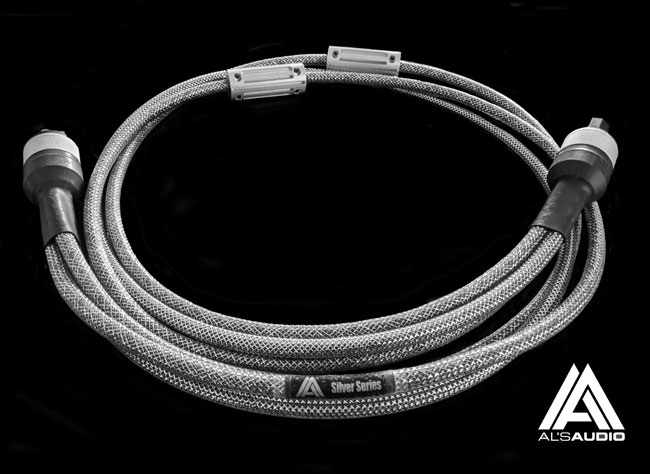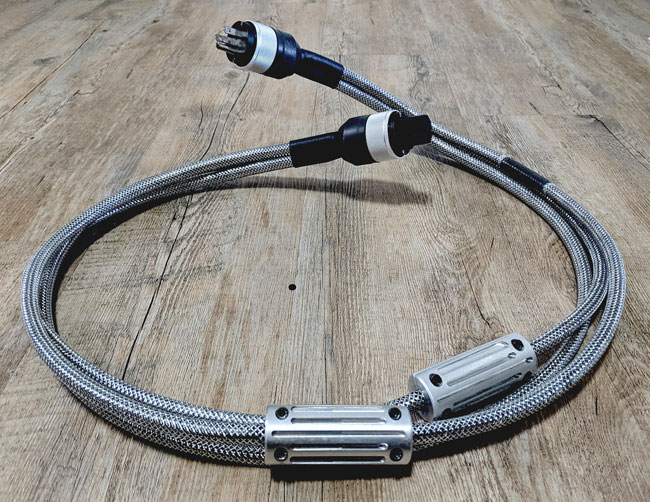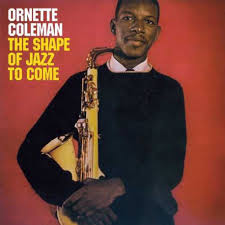Al’s Audio Silver Series AC Powercord Updated by Greg Voth

 The addition of the original Al’s Audio Silver Series Beta Power Cable to my main rig in mid-2019 coincided with the then-recent purchase of a high-quality used pair of 19 foot long silver AntiCable level 4.1 XLR’s, which proved essential in the reviewing of the Al’s Audio cable. Why? Because that triple-cable configured, Al’s Audio power cable was pretty darn stiff, even with its split 3-part linear design. My new XLR’s allowed me to move my power amp(s) between the speakers and, thus, made it easier to feed the amp with Al’s beta cable in a slow curve from the wall. With a few days of break-in already passed, I didn’t want to do a big pre-bend of the cable for install elsewhere or start break-in over again.
The addition of the original Al’s Audio Silver Series Beta Power Cable to my main rig in mid-2019 coincided with the then-recent purchase of a high-quality used pair of 19 foot long silver AntiCable level 4.1 XLR’s, which proved essential in the reviewing of the Al’s Audio cable. Why? Because that triple-cable configured, Al’s Audio power cable was pretty darn stiff, even with its split 3-part linear design. My new XLR’s allowed me to move my power amp(s) between the speakers and, thus, made it easier to feed the amp with Al’s beta cable in a slow curve from the wall. With a few days of break-in already passed, I didn’t want to do a big pre-bend of the cable for install elsewhere or start break-in over again.
The combined result of my newly acquired silver XLR cables and that original Al’s Audio beta cable, once broken in for that first week, showed great promise at first listen, displaying a palpable difference in how this system presented music compared to how it sounded at the very first power-up. Bass was far more robust and more dimensional. There were more drive and intent than ever heard from this system, and low frequencies packed a wallop that made me stop writing and look up. No multi-tasking. All ears.
Well. that original Al’s Audio review remained unpublished for a year. It wasn’t until recently that I found out that the first cable was sent out in beta. The beta power cable was the first release of the Silver Series series for Al’s Audio, located in Medicine Hat, Canada. Al’s Audio specializes in live concert and commercial installs, DJ and Pro Audio equipment sales, and home audio installs and rentals. When first seen, you’ll note that Al’s Audio Silver Series Power Cables are built with bling – sheathed in a textured bright silver in both color and sheen, and come well terminated with what appear to be excellent plugs.
I found a mention of the original cable on a forum or two then, but no presence of this product on the Al’s Audio website. With their updated cable now in hand for review, Al’s Audio website should be updated shortly to include their entire cable line. It should be noted that Al’s Audio no longer sells the old beta cables and has gone out of its way to get the original cables back through an upgrading process.
The Original Silver Series Beta Cable Technologies
 For that first review, I contacted Matthew Carter, who represents Al’s Audio, and asked a few questions about the original Silver Series beta cable’s triple-cable design, technology, and construction. Carter explained the two technologies used in the cable design were “Resonant Coupling and Flux Guide, with [the] construction based off a coaxial design.” I inquired further about these technologies and asked how they are implemented. Carter’s response follows:
For that first review, I contacted Matthew Carter, who represents Al’s Audio, and asked a few questions about the original Silver Series beta cable’s triple-cable design, technology, and construction. Carter explained the two technologies used in the cable design were “Resonant Coupling and Flux Guide, with [the] construction based off a coaxial design.” I inquired further about these technologies and asked how they are implemented. Carter’s response follows:
“Our Flux Guide technology compresses natural lines of flux, increasing the slew rate of the device it’s connected to. These Flux Guides are strategically placed and act like compressing a hose to gain a higher pressure. The result is a very strident and bright signature. We found the use of our silver resonant coupling technology combated these unwanted anomalies most effectively.
“Our Resonant Coupling is comprised of 99.99% pure silver. This Resonant Coupling is intended to alter the resonant frequency of our 10awg solid core copper conductors. A material’s natural resonating frequency inversely affects the tonality of the cable through coupling. Not only does this coupling alter the resonant frequency, but it also acts as a damper, resulting in a more stable, cleaner sound with a blacker background.
“…we utilize a coaxial design which allows us to incorporate our technologies. We chose the connectors based on appearance but, more importantly, their rhodium plating. I have noticed a slight sonic difference in the past with products plated in rhodium and thought it would match well with the sonic characteristics of the cable.”
Regarding the stiffness, Carter responded, “The cladding doesn’t really contribute to its stiffness, it just comes with its design of the cable. Unfortunately, there is no way around this. Although it’s stiff you can bend it sharply without damaging it. You almost need to mould it to what it needs to be, then install it. So yes, go ahead bend as you need to.”



The Updated Silver Series Power Cable
The updated power cable closely resembles the original, save the addition of two 2-piece aluminum cylinders bolted to two of the cable’s three arms. I reached out to Matthew Carter again with a few questions about the upgraded cable, speculating that the cylinders might contain ferrite clamps or perhaps timing adjustments (nope), and received the following response:
Carter offered further thoughts on Al’s Resonant Dispersion technology. “Conductors will vibrate as current travels through it. Very simply put, these vibrations will distort the signal. By capturing these vibrations and dispersing this energy, you will end up with a more linear signal. These are not ferrites but more like heat syncs, which also introduce a signature of their own. We went with aluminum for its ability to dissipate vibrations, and we didn’t want to weigh down the cable anymore.
“The new version not only has these couplers but 3x the Resonant Coupling. Our Resonant Coupling is comprised of 99.99% Pure silver. This Resonant Coupling is intended to alter the resonant frequency of our 10awg solid core copper conductors. A material’s natural resonating frequency inversely affects the tonality of the cable through coupling. Not only does this Resonant coupling alter the resonant frequency, but it also acts as a damper resulting in a more stable, cleaner sound with a blacker background.
“We also increased the strength of our flux guides. Our Flux Guide technology compresses natural lines of flux increasing the slew rate of device it’s connected to. These Flux Guides are strategically placed and act like compressing a hose to gain a higher pressure. The result is a very strident bright signature. We found the use of our silver resonant coupling technology combated these unwanted anomalies most effectively. These upgrades are incorporated into our entire line. We are currently offering power, RCA, digital RCA, speaker cable and XLR.”
Listening
 On Esbjörn Svensson Trio’s “Somewhere Else Before” (2008 SBME SPECIAL MKTS.), the title track had a defined and dense bottom, while the music remained airy and very free. From Gagarin’s Point Of View yielded that same density and low frequencies provided a balance of lightness and air and transient punch. The low frequencies were truly astounding.
On Esbjörn Svensson Trio’s “Somewhere Else Before” (2008 SBME SPECIAL MKTS.), the title track had a defined and dense bottom, while the music remained airy and very free. From Gagarin’s Point Of View yielded that same density and low frequencies provided a balance of lightness and air and transient punch. The low frequencies were truly astounding.
Mark Isham’s “Blue Sun,” from his1995 Columbia Records release of the same name, flowed like water – deep pulsating bass, with wide dynamics and the accompanying horns playing hushed, soft, sweet, and undeniably sonorous. There is more now here at home than what I’ve had previously experienced with this updated version. The low frequencies are determined, dimensional, and vibrant – they play the room, building far more depth and color than I think I’ve ever heard from my system prior. This new configuration with this newer Class AB power amp closer to the speakers, short speaker leads, and long silver XLR allows this power cable to participate in the presentation altogether.
What is clear is that something has been set free in this loft – it’s anxious, it’s roaming, it’s excitable… and uncaged. Petite Kid Everett from Conjure’s “Cab Calloway Stands in for the Moon” (American Clavé 1988) was equally rhythmic and dynamic and presented with great punch.
Bachianas Brasileiras No. 5 from Wayne Shorter’s “Alegria” (Verve 2003) was wide open with beautiful rosin in the string play. As always, shorter’s saxophone was exciting and right in the pocket, as it flowed around and through the accompanying players’ efforts. The percussion was terrific, tactile, textural, and dynamic. I know my face must have had a pretty broad smile on it when listening to that cello – so gloriously round and talkative when conversing with Shorter’s saxophone as they both became the singers in the song. The bass notes blossomed with added dimension, and percussive transients shone with snap and skin – everything just seemed alive.
 The Ornette Coleman penned Lonely Woman, from Pat Metheny’s “Rejoicing” (ECM 982) album, has challenging cymbals that my recently-lost friend, Mark, once described as “bacon frying” in the background – such as the state of his then-new solid-state mid-fi rig back in the ’80s. They did sizzle then, at least to his ear. I randomly began playing this disc again the month before I found out the Mark had passed and now play it in his memory. It is a lovely tune, even with the somewhat metallic brushes. Haunting and a bit hollow, this rendering itself seems a touch lonely itself – sparse, yearning and with Metheny’s typically laid back warm signature sound, this time on acoustic. With Al’s cable in place, no bacon fried.
The Ornette Coleman penned Lonely Woman, from Pat Metheny’s “Rejoicing” (ECM 982) album, has challenging cymbals that my recently-lost friend, Mark, once described as “bacon frying” in the background – such as the state of his then-new solid-state mid-fi rig back in the ’80s. They did sizzle then, at least to his ear. I randomly began playing this disc again the month before I found out the Mark had passed and now play it in his memory. It is a lovely tune, even with the somewhat metallic brushes. Haunting and a bit hollow, this rendering itself seems a touch lonely itself – sparse, yearning and with Metheny’s typically laid back warm signature sound, this time on acoustic. With Al’s cable in place, no bacon fried.
It wasn’t until Melissa Aldana’s “Free Fall” (Inner Circle Music 2010) that my ears perked up, and I withdrew from introspection. I forgot that I was playing from a “recent plays” playlist on the Mini Memory Player and was expecting Metheny. This song was far more lively and dynamic, perhaps Melissa’s less lonely. In my opinion, a far better-recorded album – Aldanna’s saxophone playing was crisp, soaring, and searching. This was one cooking band! Aldana has terrific chops, and her hunger for laying out interesting lines kept these ears happy.
Playing devil’s advocate, I swopped out the Al’s Audio cable for one of my well-broken-in Oyaide Tunami GPX-R V2 reference power cables that are priced a bit less than the Al’s Audio Silver Series beta cable but still somewhat the same ballpark. Another play of Shorter’s “Bachianas Brasileiras No. 5” (I love digital for when compelled to repeat the same track often) yielded the same dynamic, dimensional, while still light and airy, presentation as provided by Al’s cable. If I had to put a finger on any differences, I’d say the Oyaide was a touch warmer, but, again, it uses copper and has been in use for a couple of years now. The combination of the then new-to-me (used) silver AntiCable Level 4.1 XLR’s and the Al’s Audio Silver Series cable worked some nice magic, and it’s settled my configuration.
Shielding and Eccentricity
 Since reviewing the original Al’s Audio beta power cable, I have reviewed and embraced Tempest 2 cables from Dynamique Audio as my new affordable reference. Daniel at Dynamique, based in the UK, believes in removing everything extraneous from a cable’s design, including nearly all but the most necessary components, including any overabundant shielding. As such, the Al’s and Dynamique cables stand in rather stark contrast to one another – the Dynamique Tempest 2 cables are also solid silver (only the speaker cables are silver-plated copper), very flexible, very lightweight, and fast. In contrast, Al’s Silver Series are heavy and quite stiff, but they are equally speedy.
Since reviewing the original Al’s Audio beta power cable, I have reviewed and embraced Tempest 2 cables from Dynamique Audio as my new affordable reference. Daniel at Dynamique, based in the UK, believes in removing everything extraneous from a cable’s design, including nearly all but the most necessary components, including any overabundant shielding. As such, the Al’s and Dynamique cables stand in rather stark contrast to one another – the Dynamique Tempest 2 cables are also solid silver (only the speaker cables are silver-plated copper), very flexible, very lightweight, and fast. In contrast, Al’s Silver Series are heavy and quite stiff, but they are equally speedy.
For giggles, I mounted a head to head matchup, though indeed not an equal comparison. The updated Al’s Silver Series power cable presented more coherence and a touch of warmth to the picture. While the Dynamique Tempest 2 lacked a bit of cohesion, I preferred the Tempest 2 when paired with my Tekton Double Impacts, for the zing they bring this slightly warm speaker – transients were delivered with a touch more snap. Cymbals and horns arrive with a bit more of a leading edge. That the Tempest 2 cables are sold for about 1/3 of what the Al’s Silver Series updated power cable sells for, well, that’s a plus to this frugal fellow.
I certainly see the Silver Series bling needed for All’s Audio pro audio live concert installs – you can see a cable with a bright metallic sheath in the dark at a concert, so you’re less likely to trip over it.
The Wrap
The Al’s Audio Upgraded Power Cable is undoubtedly worth a demo once available on the company website, with the one caveat being their stiffness as mentioned above more than once, I suggest anyone looking for power cable in the range of price as offered by Al’s Audio demo this newly updated cable. Aesthetically, you might dig the bling and will certainly love how solidly this cable’s plugs bond to your components and wall.


greg voth
Al’s Audio Silver Series Upgraded Power Cable (6-foot length)
Price: $1568 US, $2000CND
Our upgrades are incorporated into our entire line. We are currently offering Power, RCA, digital RCA, Speaker cable and XLR cables.
Contact:
Al’s Audio
877 17 St SW
Medicine Hat, AB
Canada
Website: https://alsaudio.ca
Phone: (403) 527-1631
Email: info@alsaudio.ca
Stereo Times Masthead
Publisher/Founder
Clement Perry
Editor
Dave Thomas
Senior Editors
Frank Alles, Mike Girardi, Russell Lichter, Terry London, Moreno Mitchell, Paul Szabady, Bill Wells, Mike Wright, and Stephen Yan,
Current Contributors
David Abramson, Tim Barrall, Dave Allison, Ron Cook, Lewis Dardick, John Hoffman, Dan Secula, Don Shaulis, Greg Simmons, Eric Teh, Greg Voth, Richard Willie, Ed Van Winkle, Rob Dockery, Richard Doran, and Daveed Turek
Site Management Clement Perry
Ad Designer: Martin Perry








Be the first to comment on: Al’s Audio Silver Series AC Powercord Updated by Greg Voth